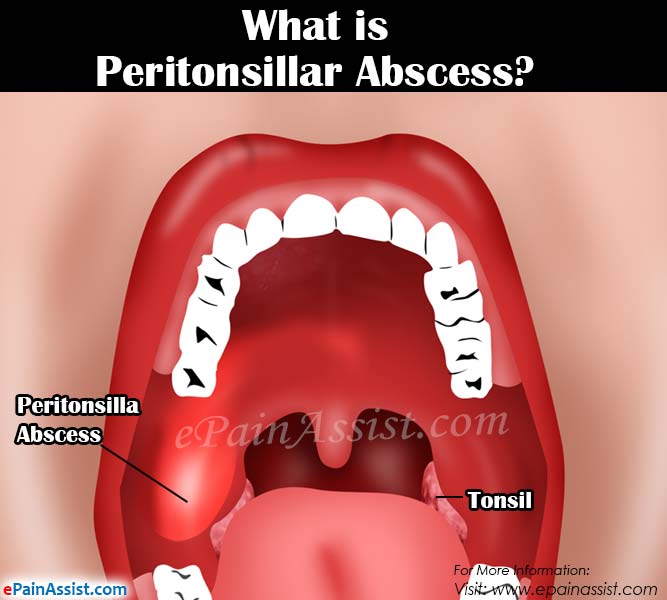What is Peritonsillar Abscess or Quinsy?
A collection of pus which forms close to an area of infected skin or other soft tissues is known as abscess. When an abscess forms in the tissues of the throat next to the tonsil it is known as peritonsillar abscess (PTA), also called quinsy. Peritonsillar abscess generally occurs when the infection of the tonsils spreads and infects the soft tissues. Peritonsillar abscess is accompanied by swelling, pain and even blockage in the throat. Speaking, swallowing and even breathing becomes difficult for ones who get a throat blockage. Peritonsillar abscess or quinsy commonly affects adults and rarely occurs in infants and young children.

Causes of Peritonsillar Abscess or Quinsy
Peritonsillar abscess or quinsy is one of the commonest complications of tonsillitis. The main causes of peritonsillar abscess or quinsy is Streptococcal bacteria. Chronic tonsillitis and dental infections, like gingivitis, periodontitis, too are some of the causes of peritonsillar abscess. Chronic lymphocytic leukemia, infectious mononucleosis and tonsilloliths are other causes of peritonsillar abscess or quinsy. Smoking also aggravates the risks of peritonsillar abscess.
Symptoms of Peritonsillar Abscess or Quinsy
The abscess forms within 2 to 5 days of the first appearance of the symptoms. The most initial symptoms of peritonsillar abscess or quinsy are severe sore throat, fever and chills. Inflammation, redness and swelling generally appear in the affected area of the mouth and throat. This swelling may also push the uvula away from the affected side of the mouth. Painful swallowing, muffled voice, ear pain, muscle spam in the neck and jaws, tender and enlarged lymph glands are other symptoms of peritonsillar abscess or quinsy.
Treatment Options for Peritonsillar Abscess or Quinsy
Diagnosis of peritonsillar abscess or quinsy is based on medical history and physical examination of the patient. The doctor can easily diagnose peritonsillar abscess if it is large enough and prominently visible. In case the abscess is not easily visible, lab tests, X-rays and ultrasound may be advised to diagnose peritonsillar abscess or quinsy accurately. Treatment options for peritonsillar abscess or quinsy needs expert care and attention. When symptoms of peritonsillar abscess appear, it is advisable to seek medical opinion. Based on the symptoms and severity of the condition, treatment options for peritonsillar abscess or quinsy are considered.
- Drainage of pus is one of the obvious treatment options for peritonsillar abscess or quinsy for severe cases. If the patient is facing life threatening breathing problems, the doctor will first try to clear the blockage in the patient’s throat and airway passage. They insert a needle in the pus pocket and drain out enough fluids to ensure that the patient can breathe comfortably.
- If the patient is not facing any immediate danger, the doctor will adopt a more painless way to treat the issue. Treatment options for peritonsillar abscess or quinsy in such cases is milder. A local anesthesia is administered into the skin over the abscess and suction is used to prevent the swallowing of blood and pus by the patient. Antibiotics and pain killers are also given in such cases.
Needle aspiration and incision and drainage are the most common ways in which doctors treat this problem. However, in case a patient is unable to tolerate the drainage procedure or has a history of tonsillitis, the best treatment option is tonsil removal or acute tonsillectomy.
Prevention of Peritonsillar Abscess or Quinsy
No reliable methods for prevention of peritonsillar abscess or quinsy are known yet. However, by avoiding smoking, by practicing good dental hygiene and by promptly treating any oral infection, one can reduce their risk of contracting this illness.
- If an individual gets tonsillitis frequently, they can prevent peritonsillar abscess by getting their tonsils removed if recommended by their doctor.
- Those who do not suffer from chronic tonsillitis face a lower risk of the abscess returning.
Taking precautions during flu, cough and tonsillitis may be an important part of prevention of peritonsillar abscess or quinsy. Patients with an uncomplicated and well-treated peritonsillar abscess generally recover completely from the illness.
Possible Complications of Peritonsillar Abscess or Quinsy
The commonest possible complications of peritonsillar abscess or quinsy are pneumonia, sepsis, meningitis, dehydration, airway blockage, infection in the tissue below the breastbone and bleeding resulting from erosion of the abscess into a major blood vessel. Most complications occur in people with a weak immune system. AIDS patients, diabetics, transplant recipients and cancer patients face a higher risk of developing such possible complications of peritonsillar abscess or quinsy.
Fever and sore throat along with trouble in breathing, swallowing and speaking can be symptoms of peritonsillar abscess. These point towards an airway obstruction which, if not treated in time, can prove to be fatal. Thus, if you or your close one is experiencing these symptoms, seek timely medical advice to find the right treatment options for peritonsillar abscess or quinsy.
